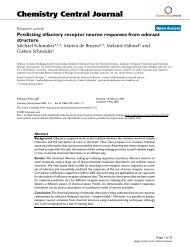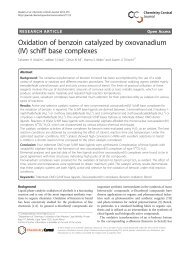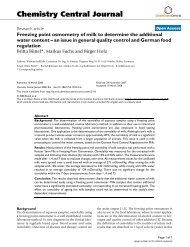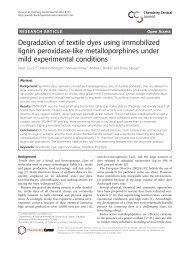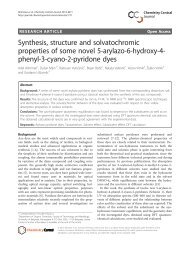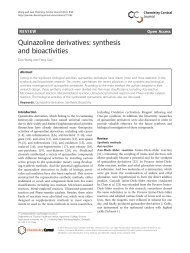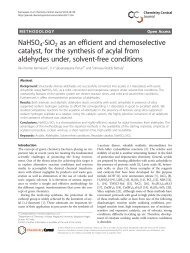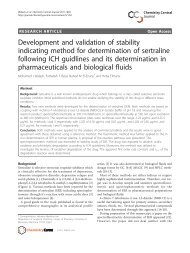Stress degradation studies and development of stability-indicating ...
Stress degradation studies and development of stability-indicating ...
Stress degradation studies and development of stability-indicating ...
You also want an ePaper? Increase the reach of your titles
YUMPU automatically turns print PDFs into web optimized ePapers that Google loves.
Musharraf et al. Chemistry Central Journal 2012, 6:7<br />
http://journal.chemistrycentral.com/content/6/1/7<br />
0.03, <strong>and</strong> 0.29 were commonly generated in both acidic<br />
reaction mixtures. In addition to those peaks, three additional<br />
peaks at R f 0.17, 0.19 <strong>and</strong> 0.73 were only generated<br />
in 1N HCl reaction mixture while four additional peaks at<br />
Rf 0.02, 0.58, 0.78 <strong>and</strong> 0.80 were only obtained under<br />
strong acidic condition (5N HCl). Moreover, 100% <strong>degradation</strong><br />
was observed under alkaline conditions. Degraded<br />
peaks were observed at R f 0.01, 0.02 <strong>and</strong> 0.50. In addition<br />
to common peaks, some additional peaks were also<br />
observed. Three peaks were at R f 0.17, 0.36 <strong>and</strong> 0.78 in<br />
0.1N NaOH, <strong>and</strong> peaks at R f 0.03 <strong>and</strong> 0.29 in 1N <strong>and</strong> 5N<br />
NaOH treated solutions, respectively. Prednisolone acetate<br />
showed 77.3% <strong>degradation</strong> by neutral hydrolysis with four<br />
additional peaks at Rf 0.01, 0.02, 0.17 <strong>and</strong> 0.29. Prednisolone<br />
acetate <strong>degradation</strong>s under wet <strong>and</strong> dry heating were<br />
95.8 <strong>and</strong> 18.5%, respectively. Both conditions showed common<br />
degraded peaks at R f 0.01, 0.17, 0.26 <strong>and</strong> 0.47, while<br />
additional peaks were observed at R f 0.29, 0.46 <strong>and</strong> 0.80<br />
for wet heating <strong>and</strong> R f 0.78 for dry heating conditions.<br />
Both oxidation mixtures, refluxed for 2 hours at 80°C <strong>and</strong><br />
24 hours at room temperature, showed 21.05% <strong>and</strong> 5.47%<br />
<strong>degradation</strong>, respectively with three common peaks at Rf<br />
0.05, 0.14, <strong>and</strong> 0.29. Under photochemical conditions,<br />
100% <strong>degradation</strong> was observed with the degraded peaks<br />
at R f 0.01, 0.29, 0.33, 0.47, 0.58, <strong>and</strong> 0.73.<br />
Prednisolone acetate showed greater <strong>degradation</strong> susceptibility<br />
to acidic, alkaline <strong>and</strong> neutral hydrolyses, wet<br />
heating <strong>and</strong> photochemical conditions. Total eighteen<br />
degraded products were observed under various stress<br />
conditions with some common <strong>and</strong> different peaks.<br />
Peaks with higher R f values indicated less polar nature<br />
than prednisolone acetate. A common degraded product<br />
with R f 0.01 was attributed to all the stress conditions<br />
except oxidation reaction. Degraded product with R f 0.02<br />
was only generated by acidic (5N HCl), alkaline (0.1, 1<br />
<strong>and</strong> 5N NaOH) <strong>and</strong> neutral hydrolysis. Peak at R f 0.03<br />
was generated under acidic (1 <strong>and</strong> 5N HCl) <strong>and</strong> alkaline<br />
(1N NaOH) hydrolysis while peaks at Rf 0.05 <strong>and</strong> 0.14<br />
were only obtained by oxidation reaction. Degraded product<br />
at R f 0.17 was commonly generated by acidic (1N<br />
HCl), alkaline (0.1N NaOH) <strong>and</strong> neutral hydrolysis <strong>and</strong><br />
wet <strong>and</strong> dry heating <strong>degradation</strong>, while peak at R f 0.26<br />
was only found in wet <strong>and</strong> dry heating conditions. Peak<br />
at R f 0.29 was found in various stress conditions including<br />
acidic (1 <strong>and</strong> 5N HCl), alkaline (1 <strong>and</strong> 5N NaOH)<br />
<strong>and</strong> neutral hydrolysis, wet heating, oxidation <strong>and</strong> photo<br />
<strong>degradation</strong>. Peaks at R f 0.33 <strong>and</strong> 0.36 are the characteristic<br />
peaks <strong>of</strong> photo <strong>degradation</strong> <strong>and</strong> alkaline hydrolysis<br />
(0.1 N NaOH), respectively. Similarly peak at R f 0.46 was<br />
only generated in wet heat <strong>degradation</strong> reaction, while a<br />
peak with R f 0.47 was observed in wet <strong>and</strong> dry heating<br />
<strong>and</strong> photo <strong>degradation</strong> conditions. Degraded product at<br />
Rf 0.58 was generated by acidic hydrolysis (5N HCl) <strong>and</strong><br />
photo <strong>degradation</strong>. Peak with Rf 0.73 was found in acidic<br />
hydrolysis (1N HCl) <strong>and</strong> photo <strong>degradation</strong>. Degraded<br />
peak at R f 0.78 was commonly generated by acidic hydrolysis<br />
(5N HCl), alkaline hydrolysis (0.1N NaOH) <strong>and</strong> dry<br />
heating. Degraded product at R f 0.80 was generated<br />
through acidic hydrolysis (5N HCl) <strong>and</strong> wet heating<br />
<strong>degradation</strong>. <strong>Stress</strong> <strong>degradation</strong> study <strong>of</strong> prednisolone<br />
acetate is summarized in Table 2. Chromatograms <strong>of</strong><br />
stress degraded products obtained from prednisolone<br />
acetate are shown in Figures 3 <strong>and</strong> 4 while video densitogram<br />
pictures are shown in Figure 5.<br />
Stability <strong>indicating</strong> property in chloramphenicol<br />
Chloramphenicol was 23.7% degraded in 1N HCl <strong>and</strong><br />
69.3% in 5N HCl. Common degraded peaks were<br />
observed at R f 0.01 <strong>and</strong> 0.04, while in strong acidic medium<br />
an additional peak generated at R f 0.81. Under alkaline<br />
conditions, chloramphenicol was 100% degraded<br />
<strong>and</strong> a common degraded peak at R f 0.01 was also generated.<br />
Under all alkaline conditions, additional degraded<br />
products were observed at R f 0.44 <strong>and</strong> 0.79, while peaks<br />
at Rf 0.81 were found in 1N NaOH treated solution.<br />
Three additional peaks at Rf 0.02, 0.04 <strong>and</strong> 0.48 were<br />
found in 5N NaOH treated solution. A single degraded<br />
product was found under neutral hydrolysis at R f 0.01.<br />
In wet <strong>and</strong> dry heat <strong>degradation</strong> conditions, two common<br />
additional peaks were found at R f 0.01 <strong>and</strong> 0.79.<br />
Under oxidation conditions, three additional peaks at R f<br />
0.01, 0.12 <strong>and</strong> 0.31 were generated, while seven<br />
Table 2 Summary <strong>of</strong> stress <strong>degradation</strong> <strong>studies</strong> <strong>of</strong><br />
prednisolone acetate (1)<br />
Rf <strong>of</strong> degraded products<br />
Degradation<br />
conditions<br />
%<br />
Degradation<br />
Acidic hydrolysis a<br />
1N HCl 76.26 0.01, 0.03,0.17, 0.19, 0.29, 0.73<br />
5N HCl<br />
Basic hydrolysis<br />
100 0.01, 0.02, 0.03, 0.29,<br />
0.58,0.78,0.80<br />
a<br />
0.1N NaOH 100 0.01, 0.02, 0.17, 0.36, 0.50,0.78<br />
1N NaOH 100 0.01, 0.02, 0.03, 0.29, 0.50<br />
5N NaOH<br />
Neutral hydrolysis<br />
100 0.01, 0.02, 0.29, 0.50<br />
a<br />
H2O 77.26 0.01, 0.02, 0.17, 0.29<br />
Wet heating a<br />
95.86 0.01, 0.17, 0.26, 0.29, 0.46, 0.47,<br />
0.80<br />
Dry heating 18.566 0.01, 0.17, 0.26, 0.47, 0.78<br />
Photochemical<br />
Oxidation<br />
100 0.01, 0.29, 0.33, 0.47, 0.58, 0.73<br />
a<br />
35%v/v H2O2 21.05 0.05, 0.14, 0.29<br />
Oxidation at room<br />
temp<br />
5.47 0.05, 0.14, 0.29<br />
a Reflux in parallel synthesizer for two hours at 80°C<br />
Page 5 <strong>of</strong> 9





